Transient Effects of Air and Oxygen Nanobubbles on Soil Moisture Retention and Soil–Substance Interactions in Compost-Amended Soil
Abstract
1. Introduction
2. Materials and Methods
2.1. Experimental Design and Treatments
2.2. Dissolved Oxygen Decay
2.3. Soil Moisture Measurements
2.4. Soil pH and Compaction Tests
2.5. Soil Water Leachate and CO2 Emissions
2.6. Statistical Analysis
3. Results
3.1. Dissolved Oxygen Decay
3.2. Air Temperature, RH, and Soil Moisture
3.3. Electrical Conductivity
3.4. Soil pH and Compaction
3.5. Nutrients and Other Substances
3.6. Soil CO2 Emission
4. Discussion
4.1. Soil Moisture
4.2. Soil Electrical Conductivity, Compaction and CO2 Emission
4.3. Chemical Composition of Leachate
5. Summary and Conclusions
Author Contributions
Funding
Data Availability Statement
Acknowledgments
Conflicts of Interest
References
- Temesgen, T.; Bui, T.T.; Han, M.; Kim, T.-I.; Park, H. Micro and nanobubble technologies as a new horizon for water-treatment techniques: A review. Adv. Colloid Interface Sci. 2017, 246, 40–51. [Google Scholar] [CrossRef] [PubMed]
- Khaled Abdella Ahmed, A.; Sun, C.; Hua, L.; Zhang, Z.; Zhang, Y.; Marhaba, T.; Zhang, W. Colloidal properties of air, oxygen, and nitrogen nanobubbles in water: Effects of ionic strength, natural organic matters, and surfactants. Environ. Eng. Sci. 2018, 35, 720–727. [Google Scholar] [CrossRef]
- Yasui, K.; Tuziuti, T.; Kanematsu, W. High temperature and pressure inside a dissolving oxygen nanobubble. Ultrason. Sonochemistry 2019, 55, 308–312. [Google Scholar] [CrossRef]
- Nirmalkar, N.; Pacek, A.; Barigou, M. On the existence and stability of bulk nanobubbles. Langmuir 2018, 34, 10964–10973. [Google Scholar] [CrossRef] [PubMed]
- Liu, S.; Oshita, S.; Kawabata, S.; Makino, Y.; Yoshimoto, T. Identification of ROS produced by nanobubbles and their positive and negative effects on vegetable seed germination. Langmuir 2016, 32, 11295–11302. [Google Scholar] [CrossRef]
- Ushikubo, F.Y.; Furukawa, T.; Nakagawa, R.; Enari, M.; Makino, Y.; Kawagoe, Y.; Shiina, T.; Oshita, S. Evidence of the existence and the stability of nano-bubbles in water. Colloids Surf. A Physicochem. Eng. Asp. 2010, 361, 31–37. [Google Scholar] [CrossRef]
- Zhou, Y.; Han, Z.; He, C.; Feng, Q.; Wang, K.; Wang, Y.; Luo, N.; Dodbiba, G.; Wei, Y.; Otsuki, A.; et al. Long-Term Stability of Different Kinds of Gas Nanobubbles in Deionized and Salt Water. Materials 2021, 14, 1808. [Google Scholar] [CrossRef]
- Agarwal, A.; Ng, W.J.; Liu, Y. Principle and Applications of Microbubble and Nanobubble Technology for Water Treatment. Chemosphere 2011, 84, 1175–1180. [Google Scholar] [CrossRef]
- Khan, P.; Zhu, W.; Huang, F.; Gao, W.; Khan, N.A. Micro-Nanobubble Technology and Water-Related Application. Water Supply 2020, 20, 2021–2035. [Google Scholar] [CrossRef]
- Meegoda, J.N.; Hewage, S.A.; Batagoda, J.H. Application of the diffused double layer theory to nanobubbles. Langmuir 2019, 35, 12100–12112. [Google Scholar] [CrossRef]
- Ramiro, B.O.; Wasielesky, W., Jr.; Pimentel, O.A.L.F.; Poersch, L.H.S.; Advent, B.; Gonçalves Júnior, G.F.; Krummenauer, D. The effect of using nano and microbubbles as aeration strategies on the nitrification process, microbial community composition, and growth of Penaeus vannamei in a super-intensive biofloc system. Aquaculture 2024, 587, 740842. [Google Scholar] [CrossRef]
- Arablousabet, Y.; Povilaitis, A. Assessing the Role of Air Nanobubble-Saturated Water in Enhancing Soil Moisture, Nutrient Retention, and Plant Growth. Sustainability 2024, 16, 5727. [Google Scholar] [CrossRef]
- Sha, Z.; Chen, Z.; Feng, Y.; Xue, L.; Yang, L.; Cao, L.; Chu, Q. Minerals loaded with oxygen nanobubbles mitigate arsenic translocation from paddy soils to rice. J. Hazard. Mater. 2020, 398, 122818. [Google Scholar] [CrossRef]
- Bhattarai, S.P.; Su, N.; Midmore, D.J. Oxygation Unlocks Yield Potentials of Crops in Oxygen-Limited Soil Environments. Adv. Agron. 2005, 88, 313–377. [Google Scholar] [CrossRef]
- Zhou, Y.; Zhou, B.; Xu, F.; Muhammad, T.; Li, Y. Appropriate dissolved oxygen concentration and application stage of micro-nano bubble water oxygation in greenhouse crop plantation. Agric. Water Manag. 2019, 223, 105713. [Google Scholar] [CrossRef]
- Zhou, Y.; Bastida, F.; Zhou, B.; Sun, Y.; Gu, T.; Li, S.; Li, Y. Soil fertility and crop production are fostered by micro-nano bubble irrigation with associated changes in soil bacterial community. Soil Biol. Biochem. 2020, 141, 107663. [Google Scholar] [CrossRef]
- Abuarab, M.; Mostafa, E.; Ibrahim, M. Effect of air injection under subsurface drip irrigation on yield and water use efficiency of corn in a sandy clay loam soil. J. Adv. Res. 2013, 4, 493–499. [Google Scholar] [CrossRef]
- Pendergast, L.; Bhattarai, S.P.; Midmore, D.J. Benefits of oxygation of subsurface drip-irrigation water for cotton in a Vertosol. Crop Pasture Sci. 2013, 64, 1171–1181. [Google Scholar] [CrossRef]
- Liu, Y.; Zhou, Y.; Wang, T.; Pan, J.; Zhou, B.; Muhammad, T.; Zhou, C.; Li, Y. Micro-nano bubble water oxygation: Synergistically improving irrigation water use efficiency, crop yield and quality. J. Clean. Prod. 2019, 222, 835–843. [Google Scholar] [CrossRef]
- Ahmed, A.K.A.; Shi, X.; Hua, L.; Manzueta, L.; Qing, W.; Marhaba, T.; Zhang, W. Influences of air, oxygen, nitrogen, and carbon dioxide nanobubbles on seed germination and plant growth. J. Agric. Food Chem. 2018, 66, 5117–5124. [Google Scholar] [CrossRef]
- Zhou, Y.; Li, Y.; Liu, X.; Wang, K.; Muhammad, T. Synergistic improvement in spring maize yield and quality with micro/nanobubbles water oxygation. Sci. Rep. 2019, 9, 5226. [Google Scholar] [CrossRef]
- Kutty, S.R.M.; Winarto, F.E.W.; Gilani, S.I.U.; Anizam, A.A.; Karimah, W.W.Z.; Isa, M.H. Degradation of organic matter using a submerged microbubble diffuser in a biological wastewater treatment system. Waste Manag. Environ. 2010, 140, 415–423. [Google Scholar]
- Liu, S.; Oshita, S.; Makino, Y.; Wang, Q.; Kawagoe, Y.; Uchida, T. Oxidative capacity of nanobubbles and its effect on seed germination. ACS Sustain. Chem. Eng. 2016, 4, 1347–1353. [Google Scholar] [CrossRef]
- Ebina, K.; Shi, K.; Hirao, M.; Hashimoto, J.; Kawato, Y.; Kaneshiro, S.; Morimoto, T.; Koizumi, K.; Yoshikawa, H. Oxygen and air nanobubble water solution promote the growth of plants, fishes, and mice. PLoS ONE 2013, 8, e65339. [Google Scholar] [CrossRef]
- Pereira, I.S.; Bamberg, A.L.; Oliveira de Sousa, R.; Monteiro, A.B.; Martinazzo, R.; Posser Silveira, C.A.; de Oliveira Silveira, A. Agricultural use and pH correction of anaerobic sewage sludge with acid pH. J. Environ. Manag. 2020, 275, 111203. [Google Scholar] [CrossRef]
- Silva, M.B.; Camargos, L.S.; Teixeira Filho, M.C.M.; Souza, L.A.; Coscione, A.R.; Lavres, J.; Abreu-Junior, C.H.; He, Z.; Zhao, F.; Jani, A.D.; et al. Residual effects of composted sewage sludge on nitrogen cycling and plant metabolism in a no-till common bean-palisade grass-soybean rotation. Front. Plant Sci. 2023, 14, 1281670. [Google Scholar] [CrossRef] [PubMed]
- Lloret, E.; Pascual, J.A.; Brodie, E.L.; Bouskill, N.J.; Insam, H.; Juárez, M.F.-D.; Goberna, M. Sewage sludge addition modifies soil microbial communities and plant performance depending on the sludge stabilization process. Appl. Soil Ecol. 2016, 101, 37–46. [Google Scholar] [CrossRef]
- Singh, R.; Singh, P.; Ibrahim, M.; Hashim, R. Land Application of sewage sludge: Physicochemical and microbial response. Rev. Environ. Contam. Toxicol. 2011, 214, 41–61. [Google Scholar]
- Singh, R.P.; Agrawal, M. Effect of different sewage sludge applications on growth and yield of Vigna radiata L. field crop: Metal uptake by plant. Ecol. Eng. 2010, 36, 969–972. [Google Scholar] [CrossRef]
- Wang, X.; Chen, T.; Ge, Y.; Jia, Y. Studies on land application of sewage sludge and its limiting factors. J. Hazard. Mater. 2008, 160, 554–558. [Google Scholar] [CrossRef]
- Kominko, H.; Gorazda, K.; Wzorek, Z. The possibility of organo-mineral fertilizer production from sewage Sludge. Waste Biomass Valorization 2017, 8, 1781–1791. [Google Scholar] [CrossRef]
- Curci, M.; Lavecchia, A.; Cucci, G.; Lacolla, G.; De Corato, U.; Crecchio, C. Short-Term Effects of Sewage Sludge Compost Amendment on Semiarid Soil. Soil Syst. 2020, 4, 48. [Google Scholar] [CrossRef]
- Ikeura, H.; Kobayashi, F.; Tamaki, M. Removal of residual pesticide, fenitrothion, in vegetables by using ozone microbubbles generated by different methods. J. Food Eng. 2011, 103, 345–349. [Google Scholar] [CrossRef]
- Paganini, E.A.L.; Silva, R.B.; Ribeiro Roder, L.; Guerrini, I.A.; Capra, G.F.; Grilli, E.; Ganga, A. A Systematic Review and Meta-Analysis of the Sustainable Impact of Sewage Sludge Application on Soil Organic Matter and Nutrient Content. Sustainability 2024, 16, 9865. [Google Scholar] [CrossRef]
- Grossiord, C.; Buckley, T.N.; Cernusak, L.A.; Novick, K.A.; Poulter, B.; Siegwolf, R.T.; Sperry, J.S.; McDowell, N.G. Plant responses to rising vapor pressure deficit. New Phytol. 2020, 226, 1550–1566. [Google Scholar] [CrossRef]
- Plante, A.F.; McGill, W.B. Soil aggregate dynamics and the retention of organic matter in laboratory-incubated soil with differing simulated tillage frequencies. Soil Tillage Res. 2002, 66, 79–92. [Google Scholar] [CrossRef]
- Franzluebbers, A.J. Water infiltration and soil structure related to organic matter and its stratification with depth. Soil Tillage Res. 2002, 66, 197–205. [Google Scholar] [CrossRef]
- Logan, T.J.; Lal, R.; Dick, W.A. Tillage systems and soil properties in North-America. Soil Tillage Res. 1991, 20, 241–270. [Google Scholar] [CrossRef]
- Warkentin, B.P. The tillage effect in sustaining soil functions. J. Plant Nutr. Soil Sci. 2001, 164, 345–350. [Google Scholar] [CrossRef]
- Targulian, V.O.; Goryachkin, S.V. Soil memory: Types of record, carriers, hierarchy and diversity. Rev. Mex. De Cienc. Geol. 2004, 21, 1–8. [Google Scholar]
- Lin, H. Three Principles of Soil Change and Pedogenesis in Time and Space. Soil Sci. Soc. Am. J. 2011, 75, 2049–2070. [Google Scholar] [CrossRef]
- Xiao, W.; Xu, G.; Li, G. Effect of Nanobubble Application on Performance and Structural Characteristics of Microbial Aggregates. Sci. Total Environ. 2021, 765, 142725. [Google Scholar] [CrossRef]
- Xiao, W.; Xu, G. Mass Transfer of Nanobubble Aeration and Its Effect on Biofilm Growth: Microbial Activity and Structural Properties. Sci. Total Environ. 2020, 703, 134976. [Google Scholar] [CrossRef]
- Silva, J.; Arias-Torres, L.; Carlesi, C.; Aroca, G. Use of Nanobubbles to Improve Mass Transfer in Bioprocesses. Processes 2024, 12, 1227. [Google Scholar] [CrossRef]
- Donnelly, S.E.; Evans, J.H. (Eds.) Fundamental Aspects of Inert Gases in Solids; Springer Science & Business Media: New York, NY, USA, 1991; Volume 279. [Google Scholar]
- Bunkin, N.F.; Shkirin, A.V.; Suyazov, N.V.; Babenko, V.A.; Sychev, A.A.; Penkov, N.V.; Belosludtsev, K.N.; Gudkov, S.V. Formation and dynamics of ion stabilized gas nanobubble phase in the bulk of aqueous NaCl solutions. J. Phys. Chem. B 2016, 120, 1291–1303. [Google Scholar] [CrossRef]
- Tan, B.H.; An, H.; Ohl, C.D. How bulk nanobubbles might survive. Phys. Rev. Lett. 2020, 124, 134503. [Google Scholar] [CrossRef] [PubMed]
- Zhang, Y.; Duan, H.; Chen, E.; Li, M.; Liu, S. Physicochemical characteristics and the scale inhibition effect of air nanobubbles (A-NBs) in a circulating cooling water system. Langmuir 2023, 39, 1629–1639. [Google Scholar] [CrossRef]
- Montazeri, S.M.; Kalogerakis, N.; Kolliopoulos, G. Effect of chemical species and temperature on the stability of air nanobubbles. Sci. Rep. 2023, 13, 16716. [Google Scholar] [CrossRef]
- Brown, P.J.; McCarty, L.B.; Quisenberry, V.L.; Hubbard, L.R., Jr.; Addy, M.B. Influence of Increasing Fines on Soil Physical Properties of U.S. Golf Association Sand. HortScience 2019, 54, 2063–2066. [Google Scholar] [CrossRef]
- Chen, W.; Bastida, F.; Liu, Y.; Zhou, Y.; He, J.; Song, P.; Kuang, N.; Li, Y. Nanobubble Oxygenated Increases Crop Production via Soil Structure Improvement: The Perspective of Microbially Mediated Effects. Agric. Water Manag. 2023, 282, 108263. [Google Scholar] [CrossRef]
- Luo, A.; Wang, T.; Luo, P.; Zheng, Z.; Fiallos, M.; Bian, Y.; Khu, S.-T. Mechanism by which micro-nano bubbles impact biofilm growth in drinking water distribution systems. Environ. Sci. Water Res. Technol. 2025, 11, 754–767. [Google Scholar] [CrossRef]
- Feeney, D.S.; Crawford, J.W.; Daniell, T.; Hallett, P.D.; Nunan, N.; Ritz, K.; Rivers, M.; Young, I.M. Three-dimensional microorganization of the soil-root-microbe system. Microb. Ecol. 2006, 52, 151–158. [Google Scholar] [CrossRef] [PubMed]
- Chen, X.; Dhungel, J.; Bhattarai, S.P.; Torabi, M.; Pendergast, L.; Midmore, D.J. Impact of oxygation on soil respiration, yield and water use efficiency of three crop species. J. Plant Ecol. 2011, 4, 236–248. [Google Scholar] [CrossRef]
- Arablousabet, Y.; Povilaitis, A. The Impact of Nanobubble Gases in Enhancing Soil Moisture, Nutrient Uptake Efficiency and Plant Growth: A Review. Water 2024, 16, 3074. [Google Scholar] [CrossRef]

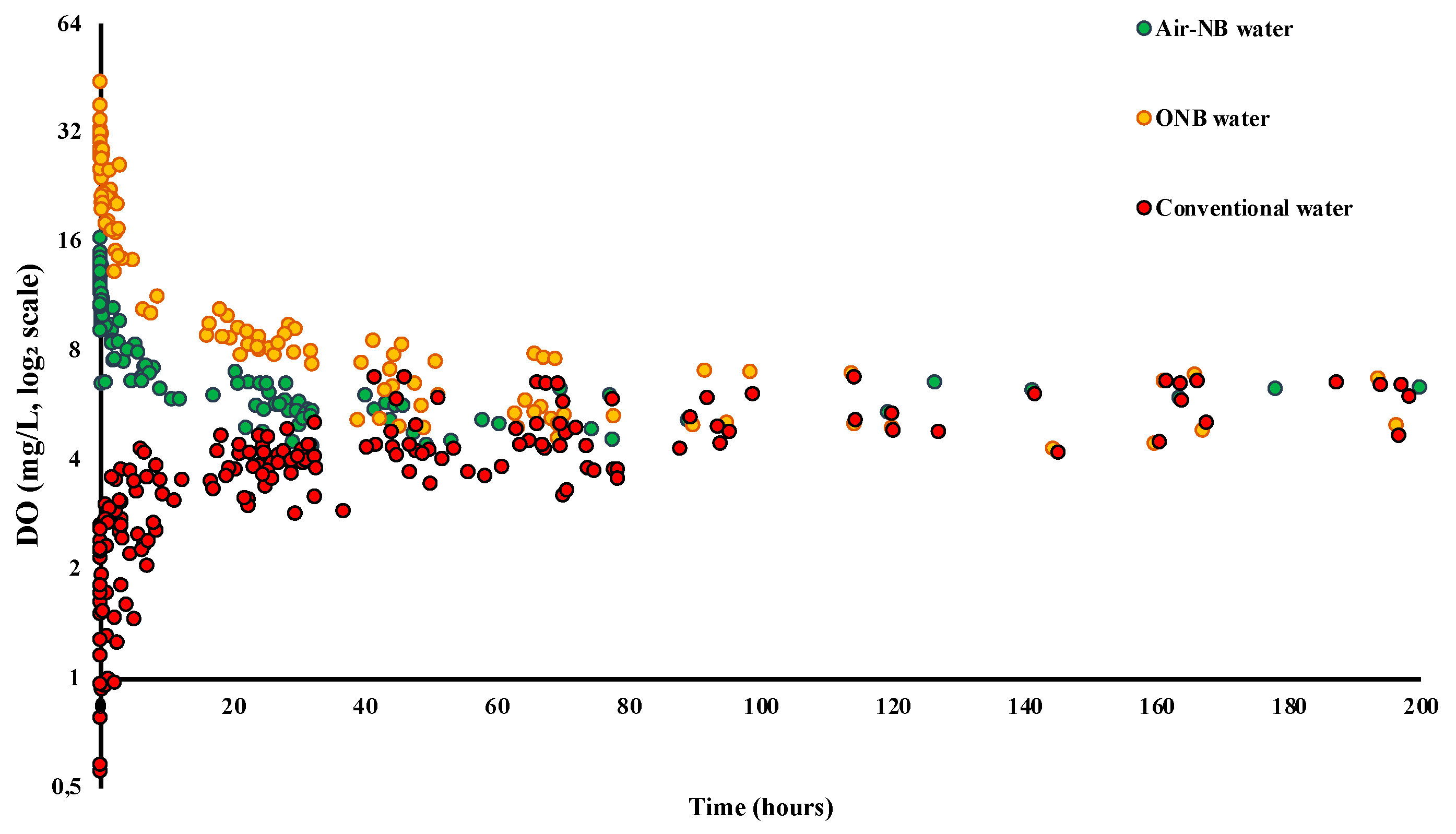
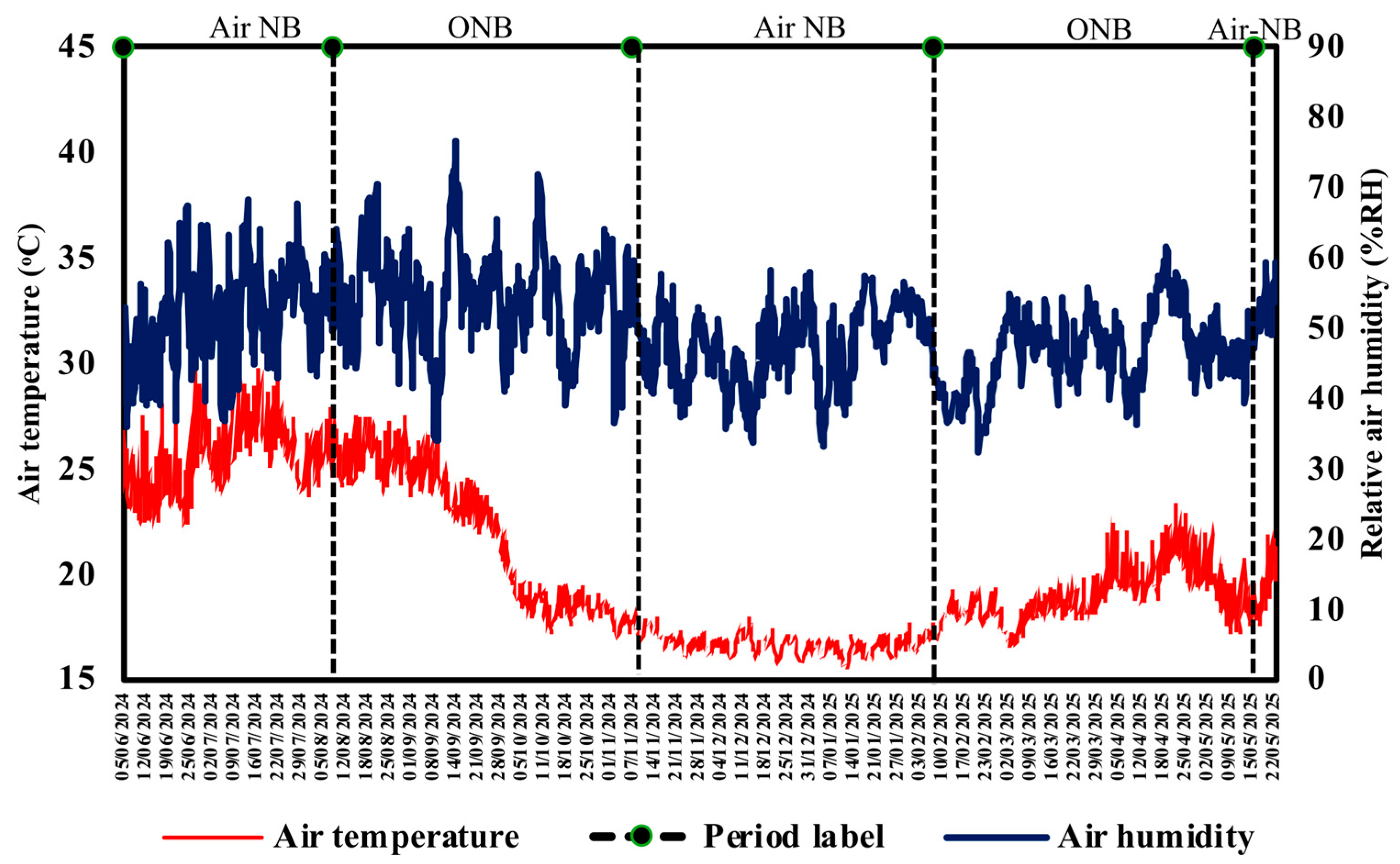


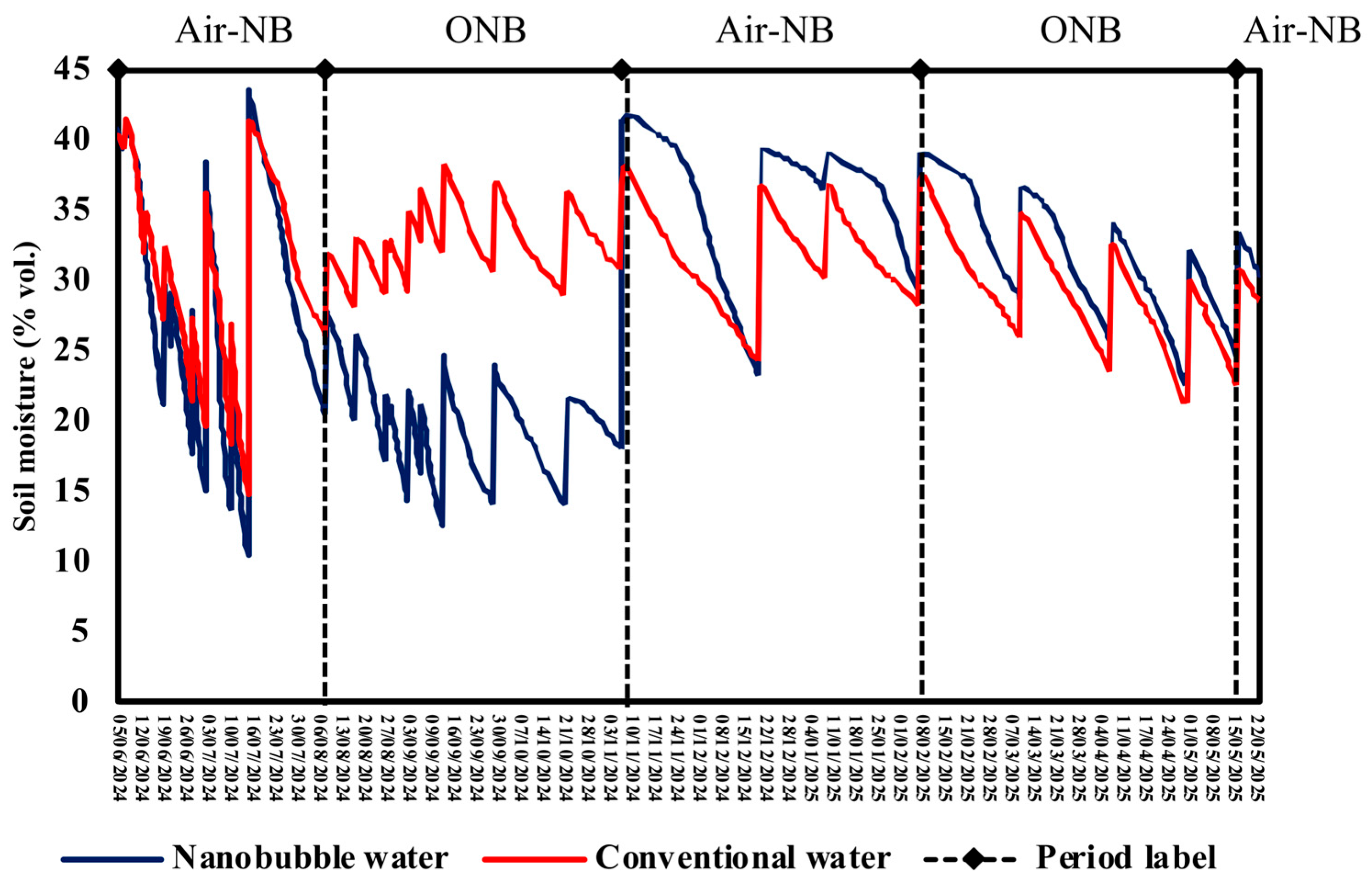

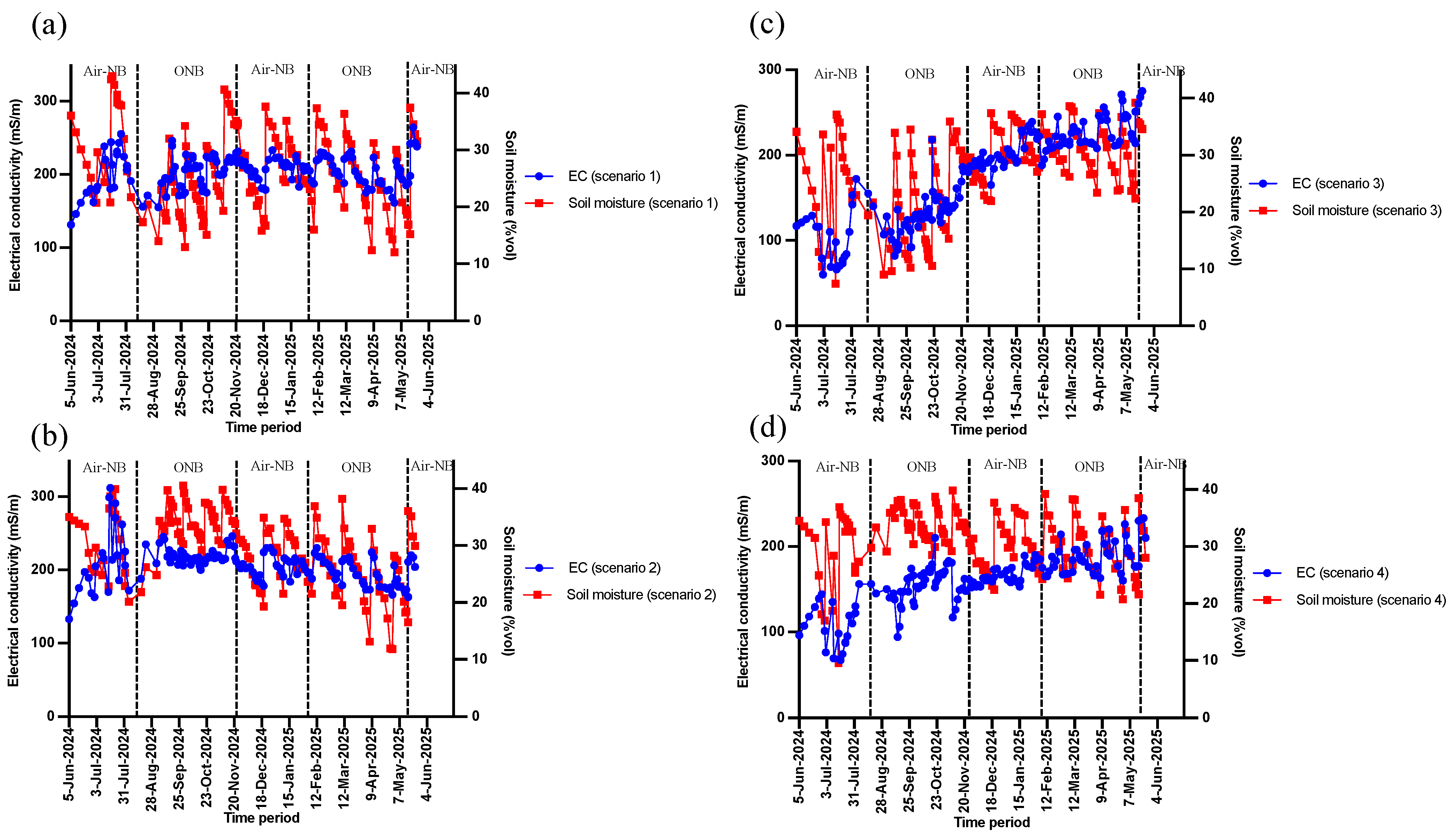



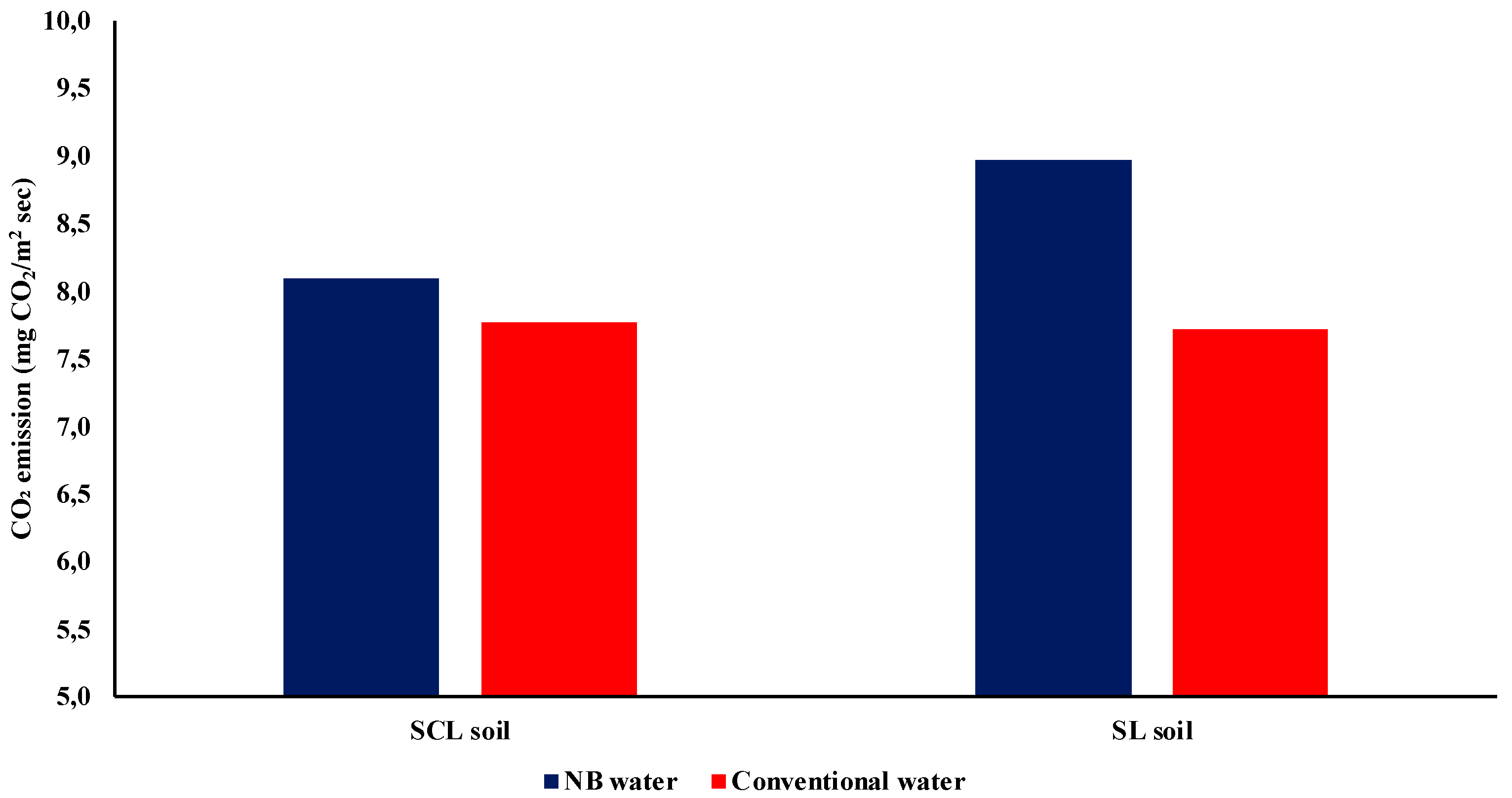
| Group | Scenario No. | Soil Type | Watering Type | Soil Composition | Soil OM % N | Composted Sludge Composition | Soil Total Nitrogen (N) (%) | Soil Total Phosphorus (P) (mg/kg) | Soil Total Potassium (K) (mg/kg) | Heavy Metal Concentration in Soil |
|---|---|---|---|---|---|---|---|---|---|---|
| E1-A | 1 | Silty clay loam | Air/oxygen nanobubble water | Clay: 13.95%, Silt: 64.25%, Sand: 21.8% | 6.35 ± 0.29 | Dry matter content: 64.05% Organic matter content: 30.27% Total nitrogen (N): 1.18% Total phosphorus (P): 0.44% Total potassium (K): 0.47% Cadmium (Cd): 0.85 mg/kg Chromium (Cr): 9.37 mg/kg Nickel (Ni): 6.10 mg/kg Lead (Pb): 15.8 mg/kg Copper (Cu): 57.7 mg/kg Zinc (Zn): 293 mg/kg Mercury (Hg): 0.028 mg/kg | 0.202 ± 0.002 | 464 | 2893 | Cadmium (Cd): 0.09 ± 0.014 mg/kg Nickel (Ni): 13.9 ± 1.47 mg/kg Lead (Pb): 7.37 ± 0.81 mg/kg Chromium (Cr): 20.4 ± 3.59 mg/kg Copper (Cu): 11.0 ± 1.45 mg/kg Zinc (Zn): 39.2 ± 4.62 mg/kg Mercury (Hg): 0.041 ± 0.007 mg/kg |
| E1-B | 2 | Silty clay loam | Conventional water | 6.35 ± 0.29 | * | ** | ||||
| E2-A | 3 | Sandy loam | Air/oxygen nanobubble water | Clay: 0.60%, Silt: 27.96%, Sand: 71.45% | 9.06 ± 0.42 | * | 0.349 ± 0.017 | 580 | 2955 | Cadmium (Cd): 0.13 ± 0.021 mg/kg Nickel (Ni): 3.20 ± 0.34 mg/kg Lead (Pb): 7.33 ± 0.81 mg/kg Chromium (Cr): 8.88 ± 1.55 mg/kg Copper (Cu): 2.56 ± 0.34 mg/kg Zinc (Zn): 26.5 ± 3.13 mg/kg Mercury (Hg): 0.058 ± 0.010 mg/kg |
| E2-B | 4 | Sandy loam | Conventional water | 9.06 ± 0.42 | * | *** |
Disclaimer/Publisher’s Note: The statements, opinions and data contained in all publications are solely those of the individual author(s) and contributor(s) and not of MDPI and/or the editor(s). MDPI and/or the editor(s) disclaim responsibility for any injury to people or property resulting from any ideas, methods, instructions or products referred to in the content. |
© 2025 by the authors. Licensee MDPI, Basel, Switzerland. This article is an open access article distributed under the terms and conditions of the Creative Commons Attribution (CC BY) license (https://creativecommons.org/licenses/by/4.0/).
Share and Cite
Povilaitis, A.; Arablousabet, Y. Transient Effects of Air and Oxygen Nanobubbles on Soil Moisture Retention and Soil–Substance Interactions in Compost-Amended Soil. Water 2025, 17, 1923. https://doi.org/10.3390/w17131923
Povilaitis A, Arablousabet Y. Transient Effects of Air and Oxygen Nanobubbles on Soil Moisture Retention and Soil–Substance Interactions in Compost-Amended Soil. Water. 2025; 17(13):1923. https://doi.org/10.3390/w17131923
Chicago/Turabian StylePovilaitis, Arvydas, and Yeganeh Arablousabet. 2025. "Transient Effects of Air and Oxygen Nanobubbles on Soil Moisture Retention and Soil–Substance Interactions in Compost-Amended Soil" Water 17, no. 13: 1923. https://doi.org/10.3390/w17131923
APA StylePovilaitis, A., & Arablousabet, Y. (2025). Transient Effects of Air and Oxygen Nanobubbles on Soil Moisture Retention and Soil–Substance Interactions in Compost-Amended Soil. Water, 17(13), 1923. https://doi.org/10.3390/w17131923






